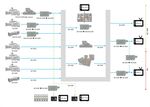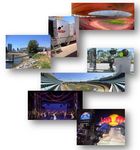HDR in der Live-Produktion - Von der Kamera bis zu einem HDR / SDR kompatiblen Workflow - TU Ilmenau
←
→
Page content transcription
If your browser does not render page correctly, please read the page content below
HDR in der Live-Produktion
Von der Kamera bis zu einem HDR / SDR kompatiblen Workflow
Klaus Weber
Principal Camera Solutions & TechnologyAgenda • UHD Options & Challenges – More Pixel – Better Pixel – Better Colors • HDR in Live Production – HDR Standards – HDR Workflows • Summary
UHD Options & Challenges
• UHD = a large palette of options to choose from:
– More Pixels
• 4K resolution
• 8x more bandwidth than HD
– Better Pixels
• High Dynamic Range
• Larger contrast in a given signal range
– Better Colors
• Extended Color Gamut
• New (incompatible) mapping of colorsUHD Options & Challenges – More Pixels
• 4K resolution
– 8x more bandwidth than HD
12G
3G
2160p
1.5G
1080p
1080i
• 4K requires much more resources than HD
– 4x 3G channels in routers, switchers, servers, etc.
• Sensitivity
– 4-times smaller UHD pixel collect 4-times less photons as HD pixels
• If same technology applied at least two f-stop lower sensitivityUHD Options & Challenges – 4K and lens diffraction
• Light rays passing through a small aperture will begin to diverge and
interfere with one another
– This becomes more significant as the size of the aperture decreases, but
occurs to some extent for any aperture or concentrated light source
Large Aperture Small Aperture
• Why does it matter more in 4K acquisition?
– In 4K acquisition the resolution loss hurts two F-stops earlier than in HD!UHD Options & Challenges – 4K and lens diffraction
5µm pixel Acceptable performance Optimal performance Optimal performance
Native HD
F8.0 F4.0 F2.0
Poor performance Acceptable performance Optimal performance
2.5µm pixel
Native 4KUHD Options & Challenges – 4K and lens diffraction
Optical Resolution
LP/mm
Focus aberration limit (HD) Focus aberration limit (4K)
4K HD
500 250
400 200
HD
Point of maximum lens resolution
4K
300 150
200 100
Desired resolution
Diffraction limit (HD)
100 50
Diffraction limit (4K)
2 4 6 8 10 12 14 16
‘sweet range,’
4K Aperture in f-stops
‘sweet range,’
HDUHD Benefits – More Pixels
• 4K resolution
– Future proof solution
– Support the trend towards
larger screen sizesUHD Options & Challenges – Better Colors
• Extended Color Gamut
– New mapping of a larger color volume
CIE 1931 = Visible colors
Pointer’s Gamut = Natural colors
BT.709 = HDTV standard gamut
• BT.709 HDTV standard does NOT support
DCI P3 = Cinema standard gamut
BT.2020 = UHD standard gamut
capabilities of latest display technology
– Current standard is still based on CRT
displays
• With the new BT.2020 nearly all natural
colors can be reproduced
– With BT.709 only about 69% can be reproduced
• But BT.709 and BT.2020 are NOT compatible with each other
– Conversion between the different color volumes is a must, but not trivialUHD Benefits – Better Colors
• Extended Color Gamut
– Support of the larger color
volume supported by the latest
television screens
• Higher saturated colors can
be reproduced without
clipping
• More natural color
reproduction possible
BT.709 versus BT.2020HDR in Live Production
Why HDR - For Artistic Reasons • High scene contrasts are often requested by the production
Why HDR - For Live
• High contrast scenes are most challenging in live broadcast applications
– Lighting conditions are
typically not under our
control
– Pictures must be perfect
at all times and can’t be
‘fixed in post’Camera-to-Display Transfer Functions
OOTF
Distribution
OETF EOTF
• OETF => Opto-Electronic transfer function => Camera transfer function
• EOTF => Electro-optical transfer function => Display transfer function
• OOTF => Opto-Optical transfer function => Artistic or rendering intentCamera-to-Display Transfer Functions - SDR
OOTF
Distribution
OETF EOTFHDR Standards - Status
• Two HDR curves are standardized worldwide for:
– Production
– Distribution
– Presentation
• SMPTE 2084 / PQ
• Hybrid Log Gamma / HLGHDR Solutions – BBC/NHK Hybrid Log-Gamma
In the upper half the
signal is mapped in a
logarithmic curve
The lower half of the
HLG signal is close to
a regular gamma curve
Source: BBC
To a SDR monitor the HLG signal look like a regular
signal where the knee point is set to a very low levelHDR Solutions – SMPTE 2084 (Dolby PQ)
• PQ use available bid depth following human eye sensitivity
– The Barten ramp describe the eye sensitivity seeing level differences
• Whatever the bid depth is PQ use it in the most optimum way
delivering the selected dynamic range
– Up to 10.000 nits
peak white are
supported
– 10 bit end-to-end
are required
as minimumHDR Standards – Requirements / PQ & HLG
• HLG offer more headroom in the darker parts of the image
– But in some of the brighter parts it is even more on the “wrong side”
– Does offer less dynamic range than PQ means its less future proof
• Conversion from one curve into the other add the weak points
of both to each other
– Any HDR
workflow must
avoid any
unnecessary
conversionWhy a native OETF should be used • How applying artistic controls in HDR
Why a native OETF should be used
Camera System
Imaging Processing Transmission
RGB linear in 14-16 bit RGB in 34 bit YCrCb in 10 bit
16.384-65.536 17.179.869.184 1.024HDR Workflows – Parallel SDR & HDR workflow
• Native SDR and HDR signals delivered simultaneously by the camera
and processed independently from each other
– Highest flexibility
• Allow optimizing SDR & HDR images independent from each other
– Double workflow require
more resources and add
complexity to the
production
• Might not be acceptable
on longer termHDR Workflows – Adopted film workflow
• What is a film workflow? “Capture and record everything what might be needed in post”
– In live the time between light reaching the imagers and the
signal gets “On Air” is typically less than 100 msec
– Live workflows currently
support 10 bit signal only
• Conversion from one 10 bit
signal into another 10 bit
signal reduces the
performance of the signalHDR Workflows – HDR workflow with SDR conversion
• Native 10 bit HDR signals from camera through the production
– For uncompromised HDR image quality
– SDR images are derived by down-mapping the HDR contend
• Require a dependable high quality conversion which can be done with
dynamic or with static
down-mapping
• Both have their strength
and their limitations
– Providing an efficient and
future proof live workflowHDR Workflows – HDR workflow with SDR conversion • Type of down-mapping define how shading need to be done
What are the challenges producing HDR?
• In most cases
quite a large
number of up- and
down-mappers are
required
– Requirements
must be
carefully
calculated
upfront to avoid
any shortageWhat are the challenges producing HDR?
• Lessons learned from test productions completed since 2014 *
– European Athletics Championships Zurich - August 2014
• First live HDR recordings in PQ/1080p
– Moto GP Final Valencia - November 2014
• First multi camera test in PQ/1080p
– Woman World Cup Soccer Vancouver - June 2015
• Comparing 4K SDR and 1080p in HDR
– Formula 1 several tests during 2016/2017
• 1080p, 4K, SDR, HDR, etc.
– LA Dodgers Baseball Los Angeles - August 2017
• Live production in HLG/1080p with dynamic down-mapping
– Cinderella Ballet at Sadler Wells London - December 2017
• 4K PQ/HLG under extremely challenging lighting conditions
– Red Bull Crashed Ice Saint Paul - January 2018
• Live production in HLG/1080p with SDR static down-mapping
* Selected events onlySummary - Understanding HDR, WCG & Workflows
• UHD has a large palette of options to choose from
• HDR (including WCG) is a major topic and for good reasons
– Much improved viewer experience independent from the screen size
• Different HDR workflow are available and all their strength and weaknesses
– Full parallel HDR / SDR workflows
– HDR/SDR workflow using conversion
• Adopted Film Workflow
• Native HDR conversion to SDRYou can also read



























































